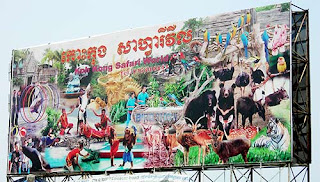
Battambang Province is a vital agricultural area, and is famous for the fertile soil which allows almost any produce to be grown in spectacular yields. Rice is its main product, and in 2003 over 500,000 tonnes of rice were produced. The Province is capable of feeding the entire country and rice from here is of the highest quality. Other local crops include corn, beans, oranges and sesame. The Province is bordered by the Tonle Sap Lake, Pursat Province and Banteay Meanchey. There are 13 Districts, 96 Communes and 741 villages. The population is 1,250,695, 52% women. Farming is the main means of livelihood. Battambang is also the Provincial Capital, and it is Cambodia’s second largest city, located on the northwestern end of the Tonle Sap. Battambang is served by National Highway No.5, and by rail, and by boat between Battambang and Siem Reap.
Rubies and garnets are mined in this Province. Culturally, Battambang also has many ancient temples dating back to the 10th and 13th centuries. These are well worth visiting, both out of historical interest, and as a chance to view the countryside beyond Battambang City.
Travel Information
Boat: Boats run daily between Siem Reap and Battambang in the wet season. Services are less frequent in the dry season because of variable water levels. There is no boat service between Phnom Penh and Battambang. Boats depart Siem Reap at 7.00am from the quay near Phnom Krom. The fare is around $12-$15 per person and the trip takes 6-8 hours. In Battambang the quay is located on the north side of town near the Rith Money bus stop.
It is not nearly as safe as travelling by road because the boats are not maintained very well and are often over-subscribed. However, the scenery is stunning, particularly around the margins of the Tonle Sap.
Bus: The Neak Krorhorm and Rith Mony bus companies run services between Siem Reap and Battambang. The cost is $4 - $5 and the journey takes around 4 hours. Buy tickets at the respective company booking offices or through a road-side ticket vendor.
There is a wider choice of services between Phnom Penh and Battambang. Neak Krorhorm, Sorya, Capitol and GST all make this run and charge around $4 for the trip, which takes about 5 hours. Contact individual companies for details of schedules and pick-up points.
Train: Battambang to Phnom Penh: trains run only on Sunday and depart at 6:20am. Travelling between Phnom Penh and Battambang, trains leave at 6.20am on Saturday. This is a rough way to travel: journey times are in double figures; carriages are in poor shape and banditry can sometimes be a problem.
http://www.ancientangkorguide.com/battambang-local-guide/











































